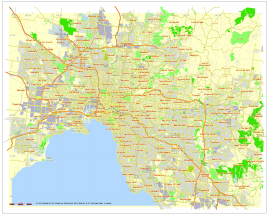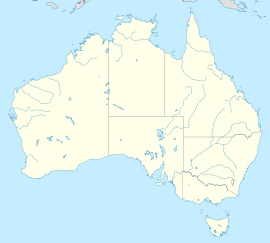
Back Мельбурн AB Melbourne AF መልበርን AM Melbourne AN ملبورن Arabic ܡܠܒܘܪܢ ARC ميلبورن ARY ميلبورن ARZ Melbourne AST मेलबर्न AWA
| Melbourne Narrm Victoria | |||||||||
|---|---|---|---|---|---|---|---|---|---|
 (From top left to bottom right) Melbourne City Centre, Flinders Street Station, Shrine of Remembrance, Federation Square, Melbourne Cricket Ground, Royal Exhibition Building. | |||||||||
 Map of Melbourne, Australia, printable and editable | |||||||||
 | |||||||||
| Coordinates | 37°48′49″S 144°57′47″E / 37.81361°S 144.96306°E | ||||||||
| Population | 3,720,300 (2006)[1] (2nd) | ||||||||
| • Density | 372.309/km2 (964.28/sq mi) | ||||||||
| Established | 30 August 1835 | ||||||||
| Elevation | 31 m (102 ft) | ||||||||
| Area | 9,992.5 km2 (3,858.1 sq mi)(GCCSA)[2] | ||||||||
| Time zone | AEST (UTC+10) | ||||||||
| Location | |||||||||
| LGA(s) | 31 Municipalities across Greater Melbourne | ||||||||
| County | Grant, Bourke, Mornington | ||||||||
| State electorate(s) | 54 electoral districts and regions | ||||||||
| Federal division(s) | 23 Divisions | ||||||||
| |||||||||


Melbourne (Woiwurrung: Narrm) is the second-largest city in Australia. It is the capital of Victoria, a state in the south-east of Australia. The population of Melbourne was just over five million in 2020.[8]
"Melbourne" is an ambiguous name. The local City of Melbourne is quite small, as the City of London is. But the metropolitan area of Melbourne is nearly 9,993 km2 square kilometers (3,858 sq mi).
Melbourne is a multicultural city (it welcomes people and cultures from all over the world). It is famous for its trams. In the centre of Melbourne is a river called the Yarra River. Melbourne also has many big parks and gardens and some beaches.
There are many things to do in Melbourne. Visitors in Melbourne can go to museums, look at art, eat food at restaurants, go to shops and visitors can enjoy of international events like Australian Open and Formula One both in the early year.
Melbourne has been the winner of the Economist's 'World's most liveable city' award seven times in a row (winner 2010–2017).
- ↑ "3218.0 – Regional Population Growth, Australia, 2015–16". Australian Bureau of Statistics. 28 July 2017. Retrieved 31 October 2017. ERP at 30 June 2016.
- ↑ "3218.0 – Regional Population Growth, Australia, 2015–16: Population Estimates by Statistical Area Level 2 (ASGS 2016), 2006 to 2016". Australian Bureau of Statistics. Australian Bureau of Statistics. 28 July 2017. Retrieved 26 October 2017. Estimated resident population, 30 June 2016.
- ↑ "Great Circle Distance between MELBOURNE and CANBERRA". Geoscience Australia. March 2004.
- ↑ "Great Circle Distance between MELBOURNE and ADELAIDE". Geoscience Australia. March 2004.
- ↑ "Great Circle Distance between MELBOURNE and SYDNEY". Geoscience Australia. March 2004.
- ↑ "Great Circle Distance between MELBOURNE and BRISBANE". Geoscience Australia. March 2004.
- ↑ "Great Circle Distance between MELBOURNE and PERTH". Geoscience Australia. March 2004.
- ↑ "A tale of three cities: Populations soar in Melbourne, Sydney and Brisbane". ABC News. 2018-04-24. Retrieved 2018-08-30.
